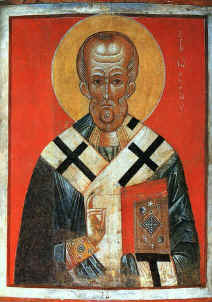Saint Nicholas
Bishop of Myra
6 December
 Nicholas was a
native of the western part of what is now Asiatic Turkey. He became Bishop of Myra in the
fourth century, and there are many stories of his love for God and for his neighbour. The
best-known story involves a man with three unmarried daughters, and not enough money to
provide them with suitable dowries. This meant that they could not marry, and were likely
to end up with a very poor lot in life. Nicholas walked by the man's house on three
successive nights, and each time threw a bag of gold in through a window (or, when the
story came to be told in colder climates, down the chimney). Thus, the daughters were
saved from a life of shame, and all got married and lived happily ever after.
Nicholas was a
native of the western part of what is now Asiatic Turkey. He became Bishop of Myra in the
fourth century, and there are many stories of his love for God and for his neighbour. The
best-known story involves a man with three unmarried daughters, and not enough money to
provide them with suitable dowries. This meant that they could not marry, and were likely
to end up with a very poor lot in life. Nicholas walked by the man's house on three
successive nights, and each time threw a bag of gold in through a window (or, when the
story came to be told in colder climates, down the chimney). Thus, the daughters were
saved from a life of shame, and all got married and lived happily ever after.
Because of this and similar stories, Nicholas became a symbol of anonymous gift-giving. Hence, if we give a gift to someone today without saying whom it is from, it can be called "a present from Saint Nicholas (or Santa Claus)." Some parents explain this to their children and invite the child to join them in wrapping a toy, and then going along to donate it to a suitable agency that will give it to someone who will welcome it. This gift is then called "a present from Santa," so that the child understands that this is another name for an anonymous gift given to someone whom we do not know, but whom we love anyway because God does.
Pictures of Nicholas often show three bags of gold next to him, and often these bags have become simply three disks or balls. Nicholas became the patron of an Italian city that was a centre of the pawnbroking business, and hence a pawnbroking shop traditionally advertises by displaying three gold balls over its front. Other stories have him saving the lives of three innocent men who had been condemned to death. Still other stories have him coming to the rescue of drowning sailors Nicholas has always been popular with children, mariners, pawnbrokers, the Dutch, the Russians, and recently, department-store owners.
In many countries, Nicholas visits children on his feast day, 6 December, and brings them gifts then. In these countries, there is usually no exchange of Christmas presents, but there may be gifts again on January 6, the feast of the coming of the Wise Men, who brought gifts to the Holy Child of gold, frankincense, and myrrh.
We are told, but it is uncertain, that Nicholas was imprisoned for his faith before the accession of Constantine, and that he was present at the Council of Nicea in 325. We may note in passing that the picture of him as roly-poly is a late development. Early stories indicate that he was generous to others, but not given to self-indulgence.
Acknowledgements:
Text adapted from James Kiefer's Christian
Biographies
Image from Carol Gerten's Fine Art